The letter G is home to some of the most interesting and enigmatic creatures in the aquatic realm. From the giant grouper to the graceful garfish, these species are amazing examples of evolution and adaptation. Let’s take a closer look at some of the fish that start with the letter G!
1. Galjoen Fish (Dichistius capensis)
Galjoen is a species of fish that lives solely along the southern coast of Africa, extending from Angola to South Africa. It enjoys the prestige of being South Africa’s national fish and is a delicacy highly regarded within their cuisine. Anglers enjoy catching galjoen for its strong fighting ability. The name “galjoen” comes from “galhão”, a Portuguese word for “large pike”. The fish grows to a length of up to 30 inches and can weigh up to 10 pounds. The average life span of the galjoen is over 20 years. The galjoen is an important species in African marine ecosystems, providing food for commercial fisheries as well as recreational anglers and contributing to biodiversity.
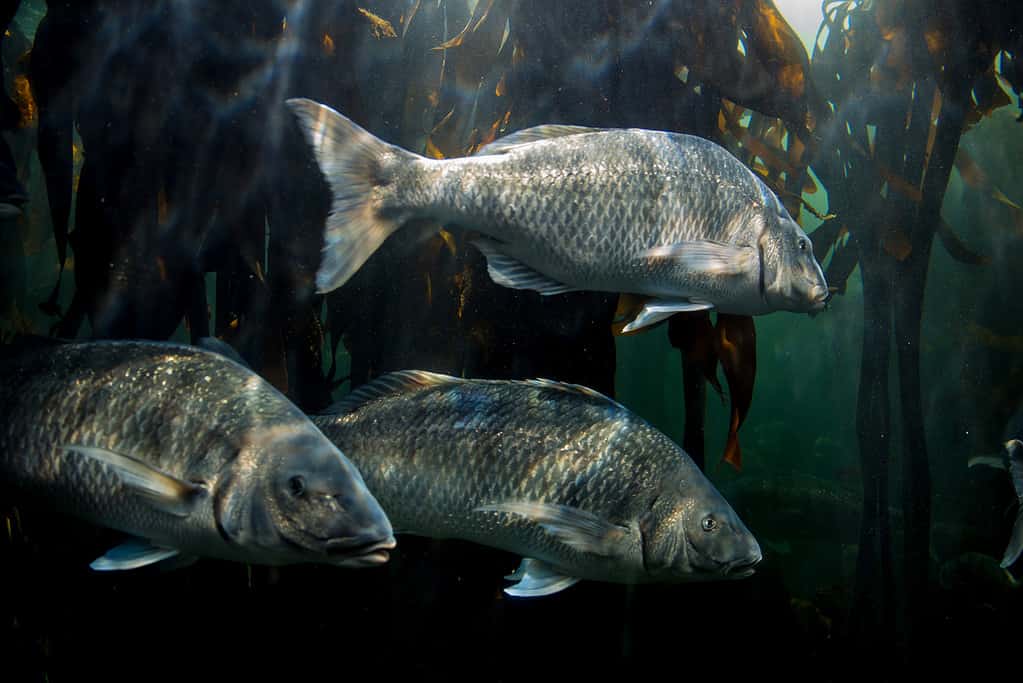
Galjoen living in rocky areas are black, while those living in sandy areas are more of a silver-bronze color.
©iStock.com/Diriye
2. Gar Fish (Lepisosteidae)
Garfish are versatile creatures that dwell in a range of habitats, from freshwater rivers and lakes to brackish swamps. Commonly found in areas with slow currents, they prefer warm waters abundant with vegetation. To survive in waters with low levels of dissolved oxygen, garfish have adapted an unconventional respiration technique. They rely on a primitive swim bladder that acts as a lung and allows them to breathe atmospheric air. The longnose gar, in particular, has an elongated snout that enables it to reach small holes and cracks in submerged logs or rocks for food. Its diet consists of aquatic insects, crustaceans, fish, and amphibians. It also feeds on the surface of the water using its long jaws.
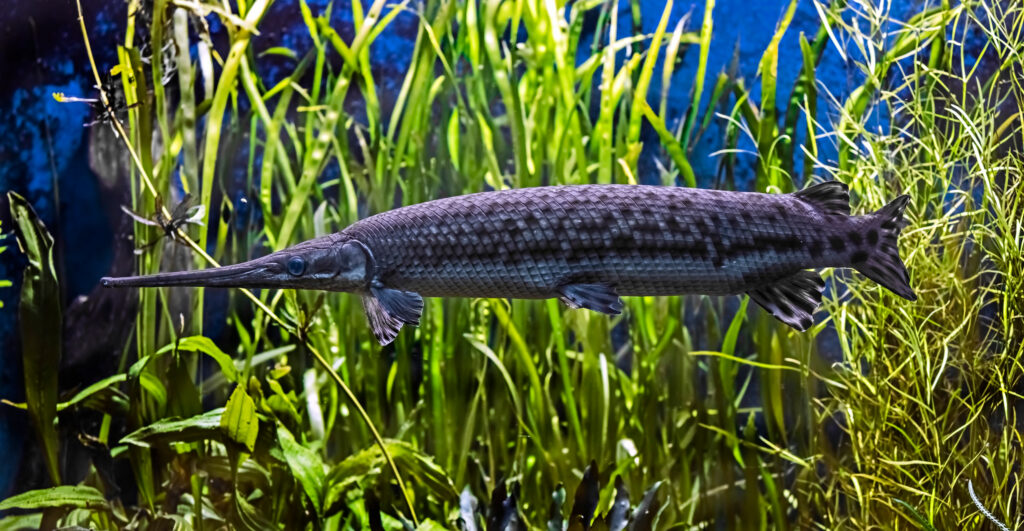
Longnose gar often lives in brackish water, freshwater lakes, brackish, and sluggish backwaters of rivers, swamps, and streams.
©Mikhail Blajenov/Shutterstock.com
3. Golden Garibaldi (Hypsypops rubicundus)
The golden garibaldi fish is native to the North Pacific Coast, from Oregon to Baja California. These fish inhabit rocky shores and reefs, as well as shallow tide pools. They feed on small invertebrates such as crabs and shrimp. As adults, these fish can reach sizes of up to 11.8 inches in length.
Golden garibaldi are bright orange with white spots on the sides. They also have a unique dorsal fin that is tall and curved, making them easily recognizable in the water. These fish usually hang out in small groups or pairs. Though they can live in both saltwater and freshwater ecosystems, golden garibaldi are most common in shallow coastal waters like those of bays and estuaries.
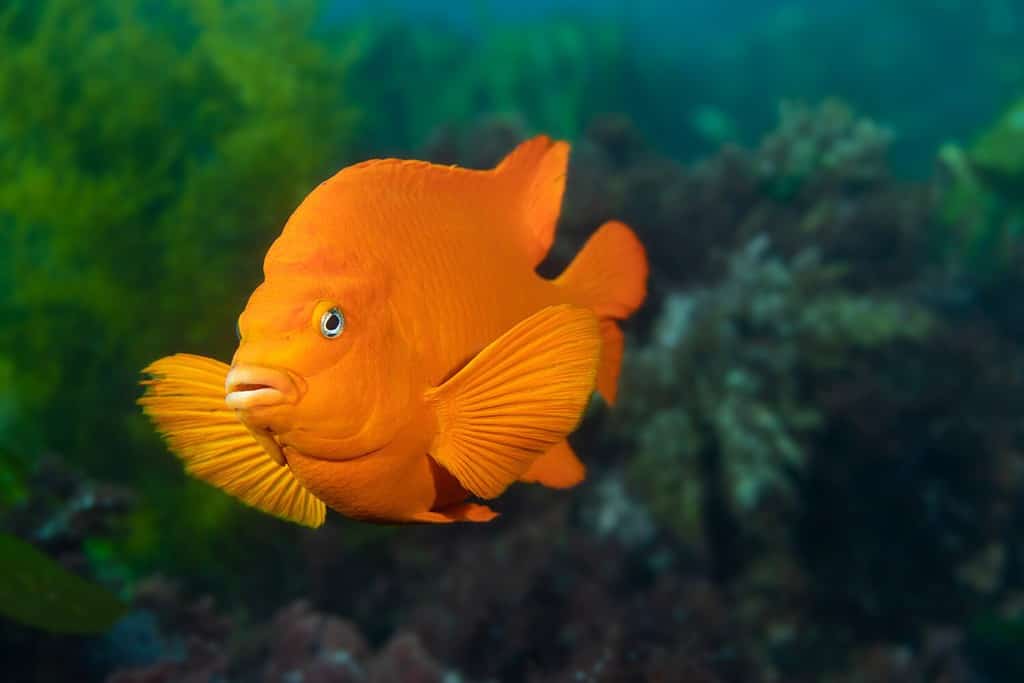
The garibaldi is the official California state marine fish.
©Joe Belanger/Shutterstock.com
4. Ghost Catfish (Kryptopterus vitreolus)
The ghost catfish, also known as the phantom catfish or glass catfish, is a species of little, translucent fish native to Southeast Asia. They are often popular aquarium pets because of their unique appearance and non-aggressive demeanor. Sporting long, pointed snouts, slender bodies with barely-visible internal organs, and no scales, they usually reach about 2 to 3 inches in length.
Ghost catfish are naturally social fish that thrive in schools of six or more. They are peaceful creatures and pose no threat to other aquatic neighbors. Additionally, caring for these fish is relatively effortless, making them a delightful addition to any community aquarium.
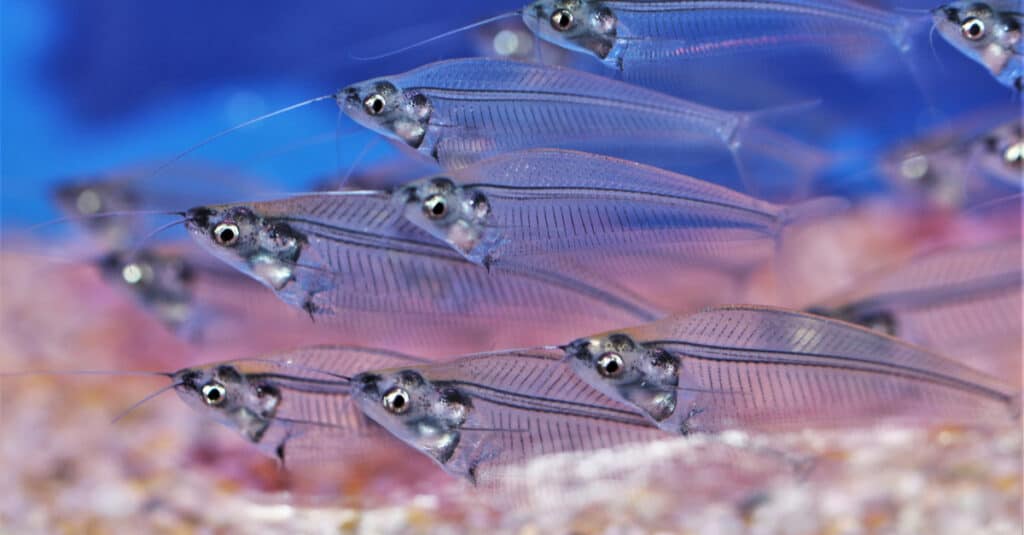
Ghost catfish are best known for their transparent or translucent bodies.
©Arunee Rodloy/Shutterstock.com
5. Ghost Flathead (Hoplichthys)
Ghost flatheads, also called spook flatheads, deep-sea flatheads, or spiny flatheads, are a family of marine fish known as Hoplichthyidae. They inhabit the Indo-Pacific region, spanning from the eastern coast of Africa to Hawaii. Typically 3.9 to 7.9 inches long, these small to medium-sized fish sport flattened bodies, large heads, and small eyes. Their bodies are sheathed in bony plates, boasting a lateral line composed of spines. A brown or yellow hue covers their form, accented by dark spots or stripes.
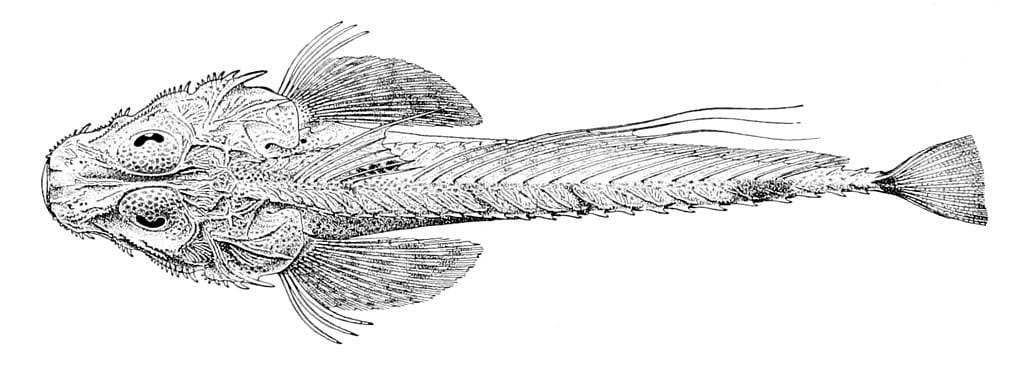
There are over 15 species of
Hoplichthys, including the lemon ghost flathead fish.
©Starks / Public domain, from Wikimedia Commons, the free media repository – License
6. Ghost Knifefish (Apteronotus albifrons)
The Amazon Rainforest is home to the ghost knifefish, a unique species of freshwater fish. Belonging to the knifefish family, they have a distinctive, elongated knife-like body that stretches 12 to 18 inches in length but can reach almost 24 inches. Ghost knifefish flash a slender, pointed snout on a translucent frame, which enhances their vision in the murky waters. Their carnivorous preference leans towards small fish, along with shrimp, and insects. Befitting their name, ghost knifefish have sharp teeth hidden behind their small mouths.
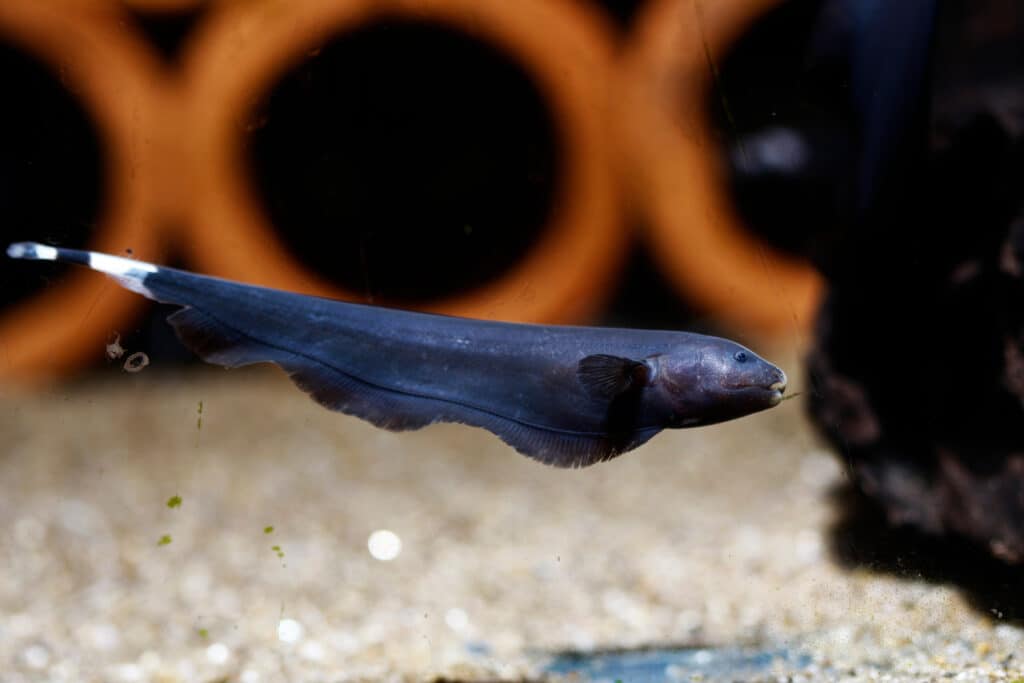
Knifefish swim by rippling their anal fins while keeping their bodies rigid.
©Pavaphon Supanantananont/Shutterstock.com
7. Ghost Pipefish (Solenostomus paradoxus)
Ghost pipefish, found in tropical waters worldwide, are small, slender fish related to seahorses and pipefish. Unlike their relatives, however, they possess unique characteristics, such as two dorsal fins and star-shaped plates on their skin that provide superb camouflage. Transparent or translucent, these charming fish, typically 2 to 3 inches long, use their pointed snouts to suck up small crustaceans and other invertebrates.
Ghost pipefish reside in shallow water, often near coral reefs. Though generally solitary creatures, they may gather in small groups during the breeding season. Egg-laying falls to the female, who then deposits her eggs in the male’s brood pouch. The male fertilizes the eggs and assumes responsibility for their care until they hatch.
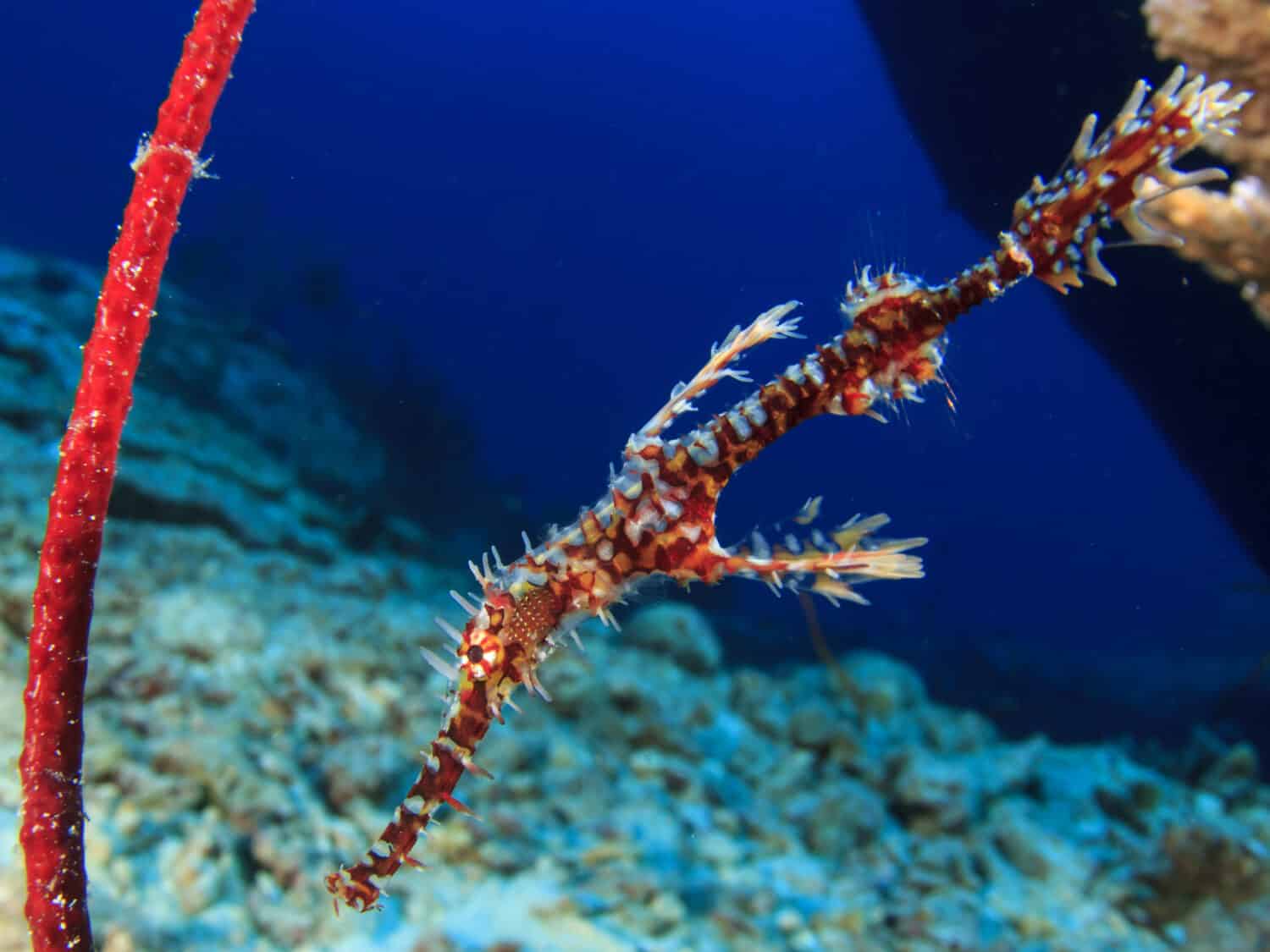
The ghost pipefish lives in the Indian Ocean and Western Pacific Ocean.
©Greens and Blues/Shutterstock.com
8. Ghoul (Inimicus)
Ghoul fish have an affinity for shallow waters, dark mottled coloration for blending into the ocean floor, sharp spines, and other unique defenses against predators. They play a crucial role in the marine ecosystem by regulating populations of small fish and invertebrates, but interacting with them requires precautions to avoid harm to humans.
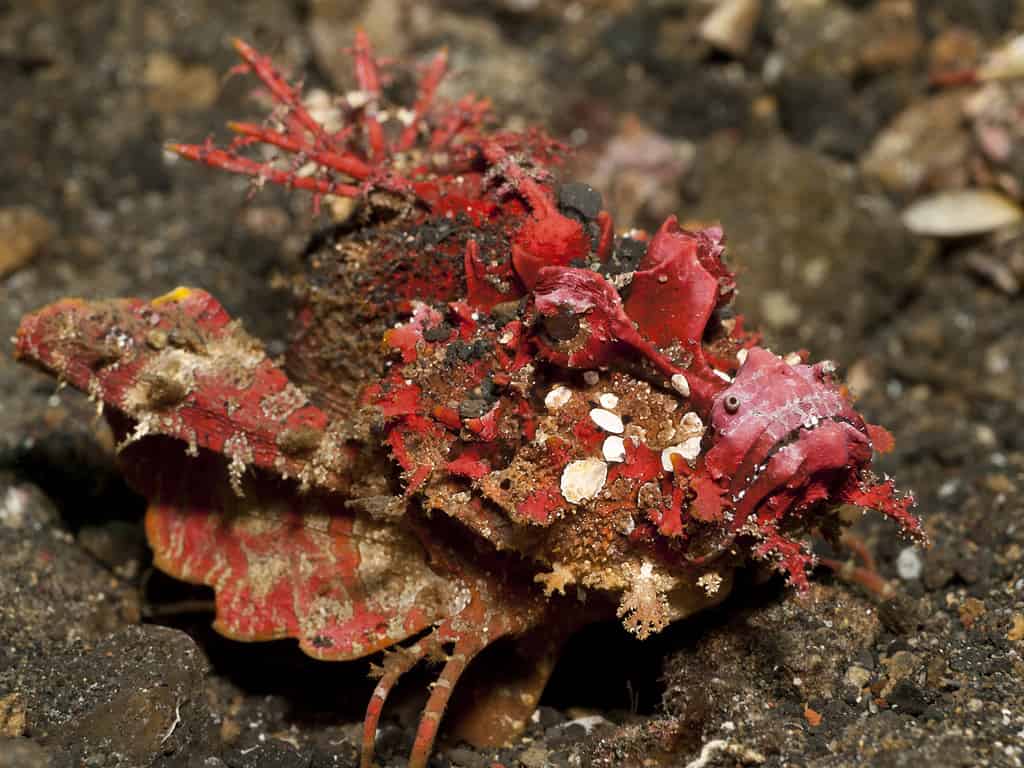
Ghoul fish go by many ominous names, such as sea goblin, goblinfish, stinger, stingfish, and spiny devilfish.
©iStock.com/semet
9. Gibberfish (Gibberichthyidae)
Gibberfish are a family of small, deep-sea fish that comprises a single genus, Gibberichthys (named after the Latin “gibba,” meaning “hump-backed,” and the Greek “ichthys,” meaning “fish”). There are currently two recognized species in this genus: Gibberichthys pumilus and Gibberichthys latifrons.
The gibberfish is a small fish that lives in the tropical Western Atlantic, Western Indian, and Western and Southwestern Pacific Oceans. It primarily inhabits depths of about 1,312 to 3,280 feet. With a humpbacked body, these fish have small eyes and a rather large head. Their bodies are covered in tiny scales, and they feature a singular dorsal and anal fin. As a deep-sea fish, the Gibberfish is equipped with bioluminescent organs that emit signals to attract prey.

Gibberfish are strange and unique fish that live at depths between 1,312 and 3,280 feet.
©Liesa.aqua.photography / CC BY-SA – License
10. Gila Trout (Oncorhynchus gilae)
The term “Gila” originated from the Gila River, which is the existence of these fish was initially identified. The Gila trout is a species of freshwater fish that only lives in the Southwest United States. A member of the salmon family and a close relative of the rainbow trout, the Gila is known for its slender body, small scales, single dorsal and anal fins, and olive green or brown color, adorned with stripes or dark spots. On average, they measure 12 to 18 inches although some can grow up to 24 inches in length. These gorgeous creatures are known for their anadromous behavior. This means they come into existence in freshwater, before migrating to the ocean to fully mature. Subsisting on a delightful mix of tiny fish, insects, and crustaceans, these remarkable beings are a true wonder of nature.
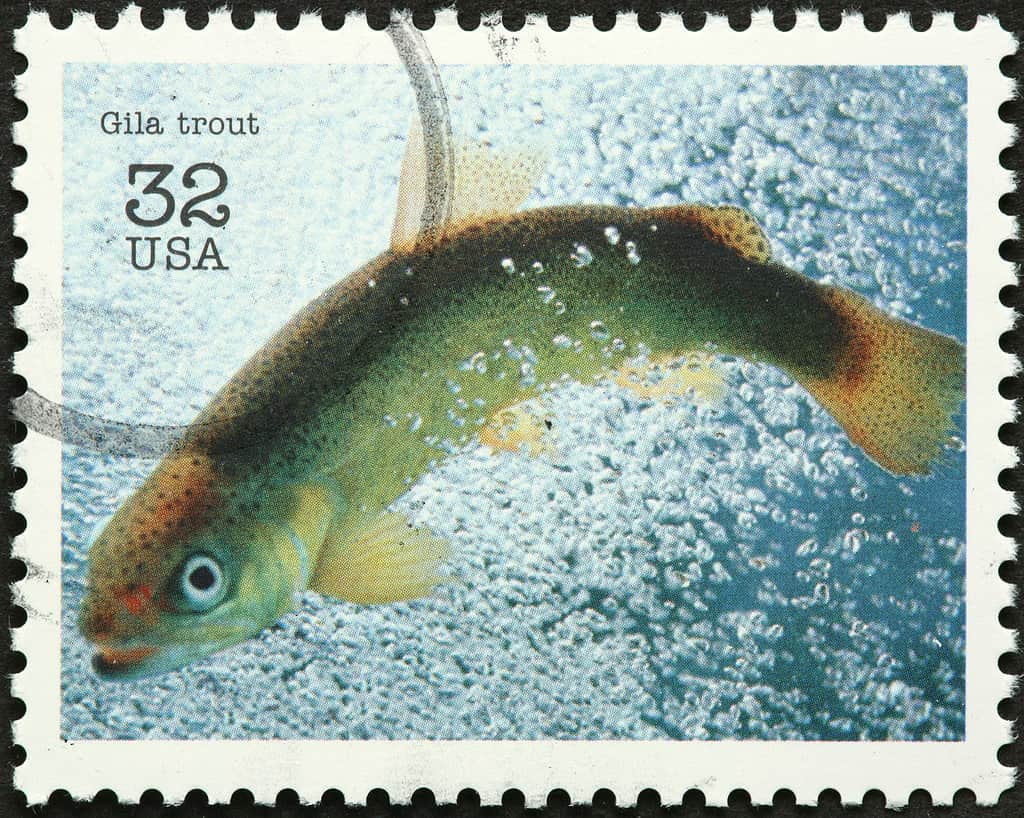
Gila trout are an endangered species.
©iStock.com/raclro
11. Glassfish (Parambassis ranga)
Glassfish, also referred to as Indian glassy fish, Indian X-ray fish, or Indian glassy perch, belong to the Asiatic glassfish family Ambassidae of order Perciformes, and originate from South Asia, spanning from Pakistan to Vietnam, Malaysia, and Bangladesh. These translucent freshwater fish, usually about 3 inches in length, reveal their delicate bones and organs through their almost transparent skin. Glassfish are schooling fish and thrive in groups of at least five. Exuding peace and tranquillity, they blend in harmoniously among other fish, making them a well-sought-after aquatic pet. Their active behavior, constantly swimming around, adds life and vivacity to any aquarium.
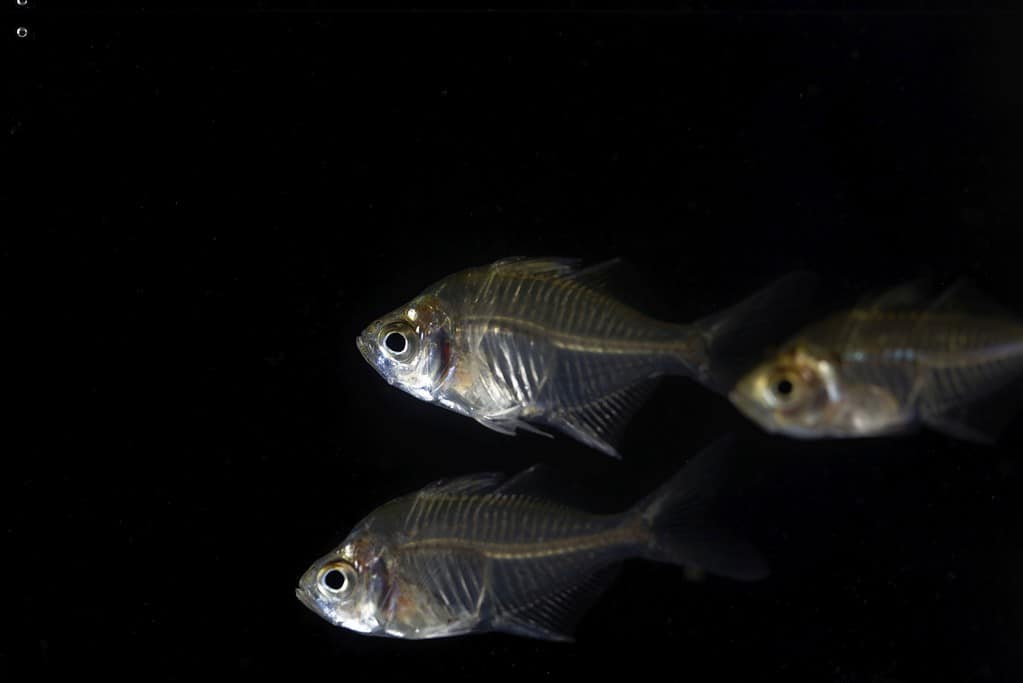
Glassfish live in South Asia, but they are also common in fish tanks and aquariums.
©iStock.com/weisschr
12. Goatfish (Mullidae)
Goatfish, also known as red mullets, are a family of fish (Mullidae) in the order Perciformes. More than 100 species of these fish inhabit tropical and subtropical waters worldwide. Goatfish have two long, fleshy barbels under the tip of their chin to detect food in the sand and communicate. Though they’re usually 12 to 18 inches long, some species can grow up to 3 feet long with a slender body and a long, pointed snout.
Goatfish are a vital part of the marine ecosystem as they help to regulate the population of small invertebrates. These bottom-feeding fish form the core of their diet by preying on small invertebrates, such as shrimp, crabs, and worms, while they occasionally eat algae and plant matter.
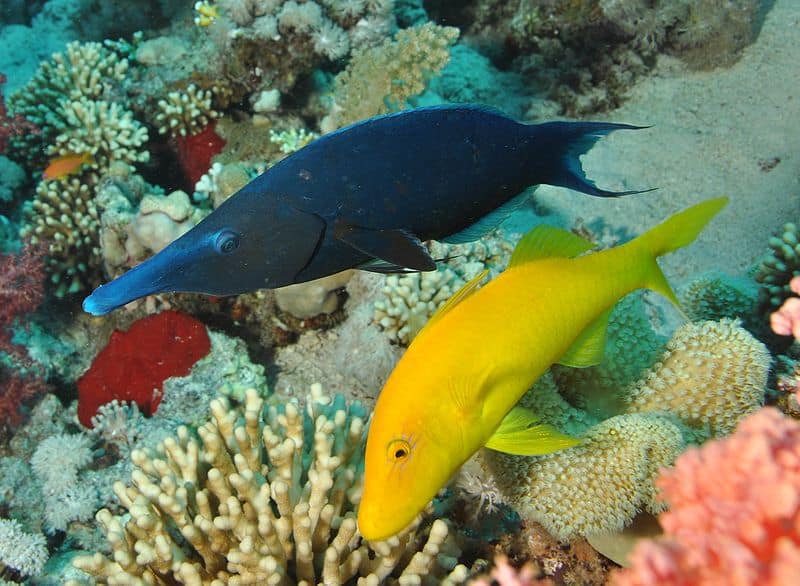
Green Birdmouth Wrasse swimming with Yellow Goatfish. Goatfish get their name from the two barbels under their chin, which resemble a “goatee”.
©Albert kok, CC BY-SA 3.0, via Wikimedia Commons – License
13. Goldeye Fish (Hiodon alosoides)
Goldeye fish are freshwater species native to Canada and the northern U.S. Being one of only two living species in the Hiodontidae family, the species name alosoides means “shad-like” (shad is another type of fish). Goldeyes inhabit freshwater environments such as large rivers, lakes, and reservoirs with clear to turbid water. These fish are anadromous, hatching in freshwater and maturing in saltwater. With spawning taking place in the spring, their eggs hatch within mere days, and their offspring remain in freshwater for several years before venturing out to the ocean.
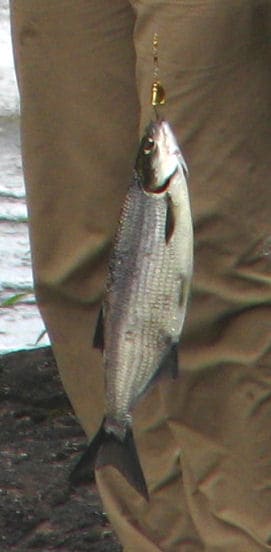
Goldeye fish closely resemble herrings.
©D. Gordon E. Robertson / CC BY-SA 3.0 – License
14. Gizzard Shad (Dorosoma cepedianum)
The freshwater and brackish waterways of North America are home to the gizzard shad, a small herring fish reaching lengths of 12 to 18 inches. Sporting silvery-green coloration up top and plain silver underneath, it boasts a deep body, a small mouth and head, and a long, slender filament on the last ray of the dorsal fin.
Gizzard shad are unique filter feeders with a special organ: the gizzard. The gizzard assists in crushing food particles sifted from water. These species play a vital role in the freshwater ecosystem, providing sustenance for a variety of animals including larger fish, birds, and turtles.
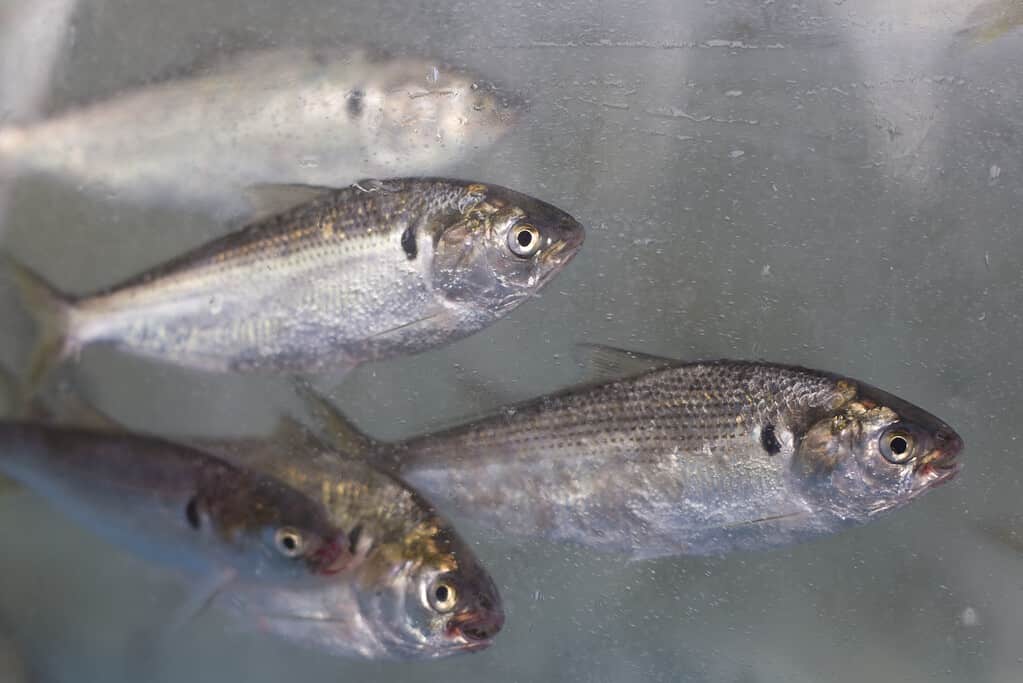
Gizzard shad, sometimes also called mud shad, are gray or brown fish that live in brackish and freshwater habitats.
©iStock.com/bong hyunjung
15. Greenlings (Hexagrammidae)
The North Pacific Ocean is home to a group of marine fish known as greenlings. These fascinating creatures are members of the Hexagrammidae family, alongside rockfish, lings, and scorpionfish. Coming in over 50 diverse species, greenlings range in length from a few inches to several feet.
Greenlings can easily be identified by their small scales, strong jaw teeth, and long dorsal fins. These fish generally possess shades of green or brown coloration, with darker spots or stripes scattered across their sleek bodies. As bottom-dwelling creatures, greenlings feast upon small invertebrates, including shrimp, crabs, and worms, whilst also taking to consuming plant matter and algae.

A kelp greenling underwater. Greenling fish are carnivorous and have very strong jaw teeth.
©NatureDiver/Shutterstock.com
16. Grenadier (Macrourinae)
Grenadiers, or rattails, are deep-sea fish that are ubiquitous across all oceans. They belong to the largest fish family, Macrouridae, within the Gadiformes order. With over 300 species, ranging from just inches to several feet long, grenadiers are diverse in size.
Grenadiers are characterized by their large heads, long bodies, and rat-like tails. They have small scales, and their bodies are typically brown or black. Grenadiers are bottom-dwelling fish, and they feed on a variety of small invertebrates, such as shrimp, crabs, and worms. They are also known to eat fish eggs and other small fish.
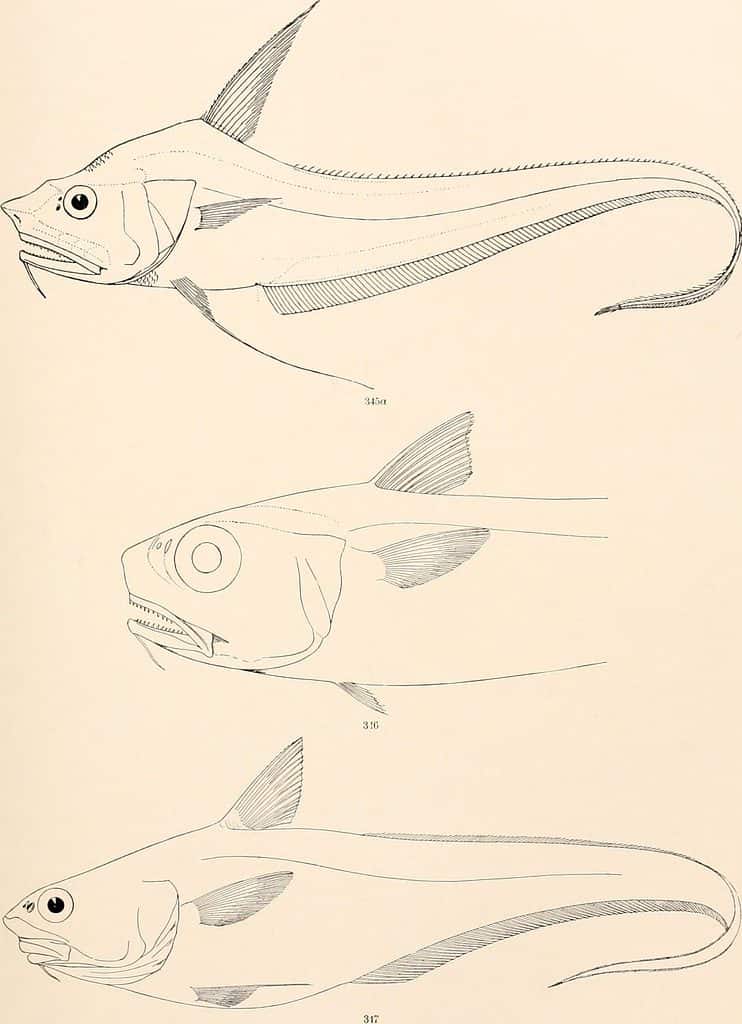
An illustration of a globehead grenadier. Grenadier fish have long skinny tails, which is why they are sometimes called rattail fish.
©Internet Archive Book Images / CC0 1.0, Flickr – License
17. Grouper (Mycteroperca)
Groupers, found in tropical and subtropical waters the world over, are a diverse ensemble of saltwater fish with over 400 species. Sporting a range of colors such as brown, green, red, and yellow, groupers have stout frames and oversized mouths. Groupers may vary in weight, from just a few pounds to over 600 pounds! These fish are a vital component of the marine ecosystem, feeding on various prey, including fish, crabs, shrimp, and squid, as docile bottom-dwelling creatures. They are ambush predators that wait in stealth for potential prey to approach before pouncing, helping to control populations of other fish in the area.
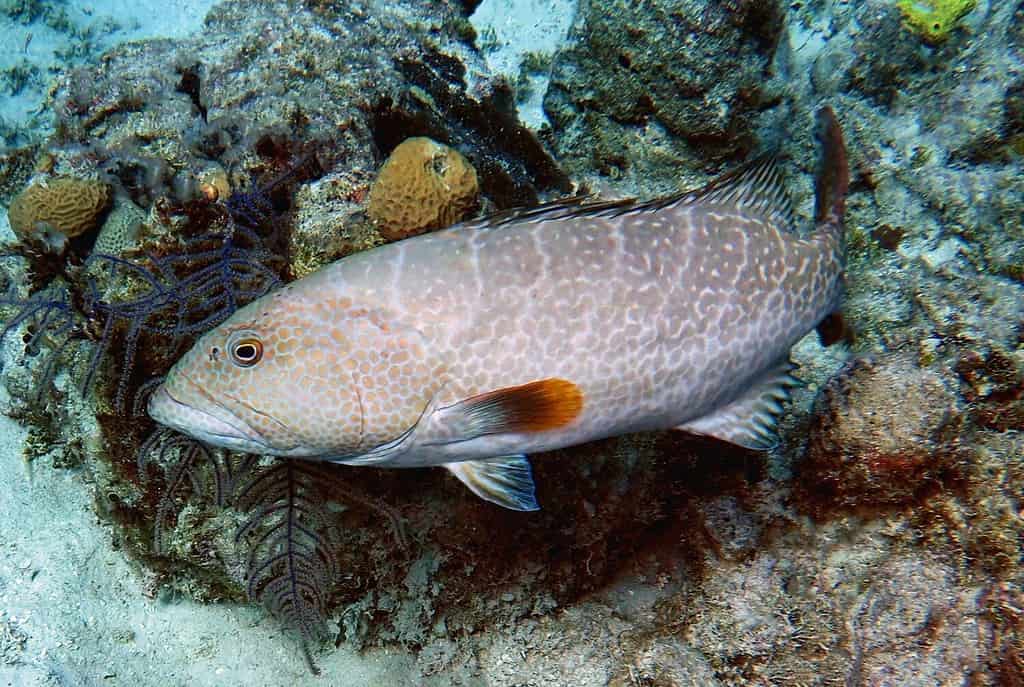
There are over 400 different species of grouper out there in the world. This one is the yellowfin
grouper
.
©Daryl Duda/Shutterstock.com
18. Grunion (Leuresthes)
Grunion, a type of small silverside fish, inhabits the coasts of Southern California and northern Baja California. These creatures are noteworthy for their exceptional spawning behavior, which sees females lay their eggs on the beach after emerging from the water. Typically measuring about 5 to 6 inches, grunion have a svelte body with a prominent head, and their backs exhibit a silvery-green hue while their bellies are silvery-white. These fish feature a solitary dorsal fin and a small anal fin.
During the spring and summer, the perfect combination of high tides and wet sand creates a remarkable phenomenon. The females emerge from the water, dig a shallow trench with their tails, lay their eggs, and cover them with sand to create a cozy incubator for their offspring. The males fertilize the eggs, and in about 10 days, the next generation of grunion is born and navigates back into the ocean.
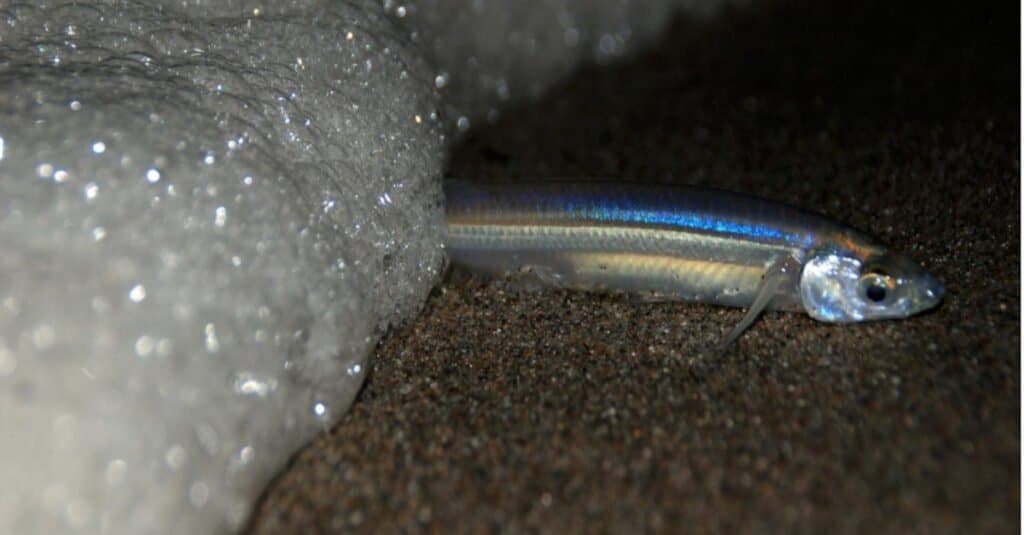
Grunion is known for its unusual mating ritual. At very high tides, the females come up onto sandy beaches where they dig their tails into the sand to lay their eggs.
©iStock.com/Steve Howard
19. Guitarfish (Rhinobatidae)
Guitarfish, a unique genus of rays, inhabit warm, subtropical waters all across the globe. These fascinating creatures have an intriguing body structure; their elongated bodies are flattened along the head and trunk areas, highlighting their small, wing-like fins. Several species of guitarfish occupy waters ranging from tropical to warm temperate zones, spreading their sensational charm far and wide.
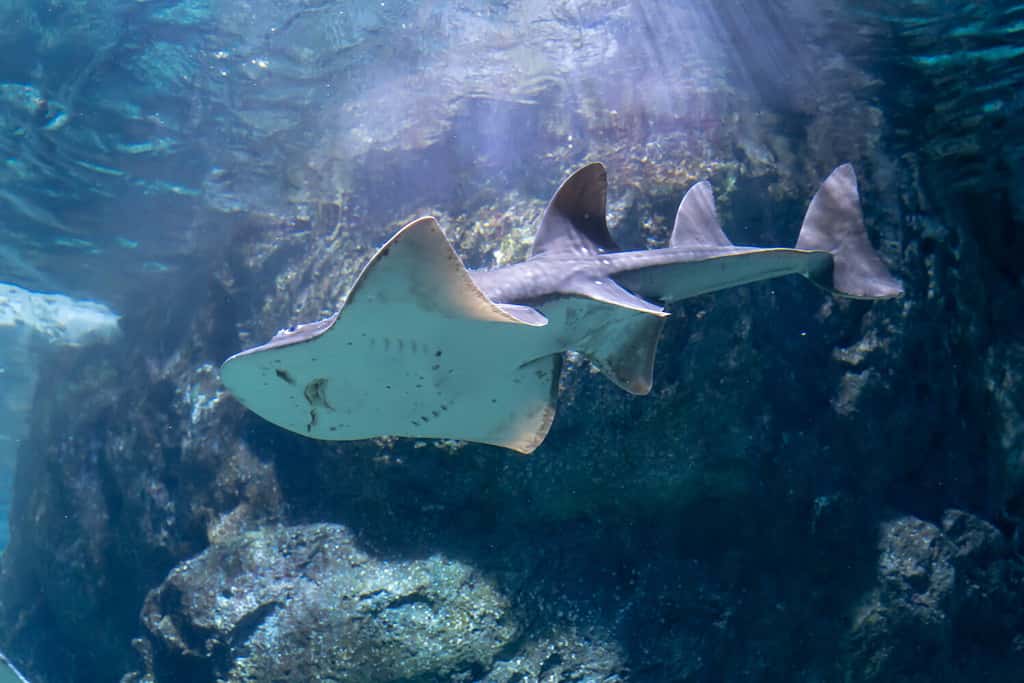
Guitarfish are sometimes also called shovelnose rays.
©chonlasub woravichan/Shutterstock.com
20. Gunnel Fish (Pholidae)
Gunnels belong to a family of fish known as Pholidae and live in the northern regions of the Atlantic and Pacific oceans. These distinct critters have long eel-like bodies, and small fins, and typically sport a brown or green hue. They easily adapt to varied environments such as rocky shores, tide pools, and kelp forests.
Gunnel fish are predators that reside at the bottom of the ocean and prey on a variety of small invertebrates including shrimp, worms, and crabs. Small fish are also fair game for these creatures.
Gunnels play an important role in the ocean’s ecosystem as these fish keep the population of small invertebrates in check.
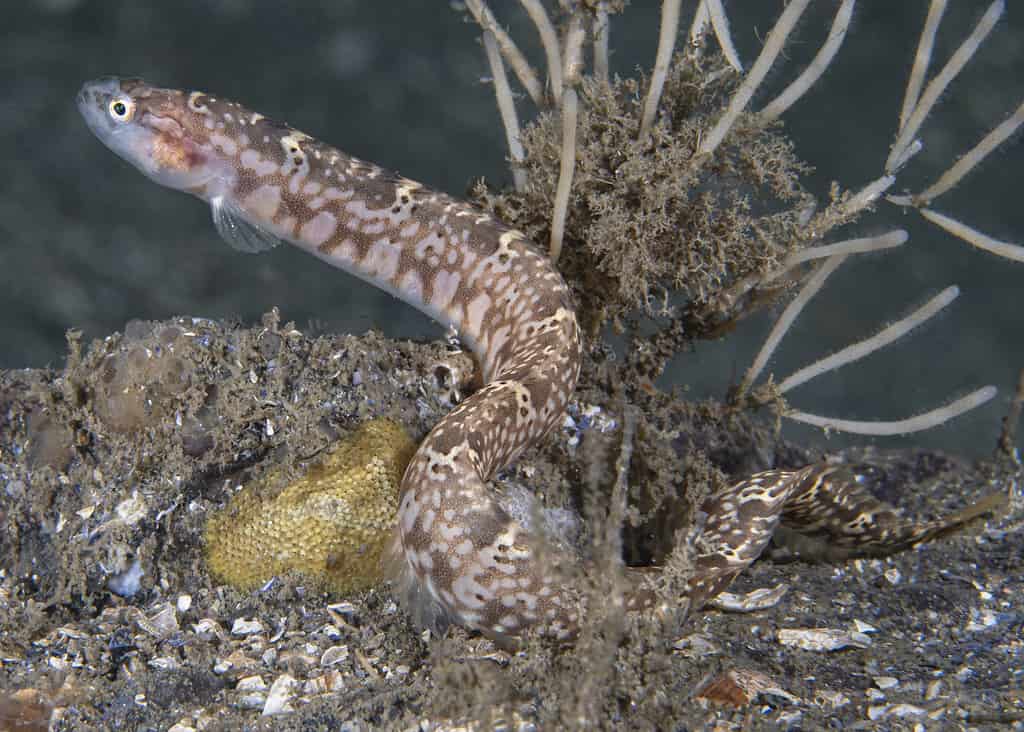
The longfin gunnel lives in rocky areas and has a silver and magenta-colored body.
©iStock.com/Aiden Conners
21. Gurnard Fish (Triglidae)
Gurnards, belonging to the Triglidae fish family, inhabit temperate and tropical waters worldwide. Their defining features are their sizeable heads, long pectoral fins, and robust jaw teeth. Usually found in rocky shores, sandy bottoms, and kelp forests, gurnards come in a range of colors but are commonly brown or green.
As bottom-dwelling predators, gurnards prey on small invertebrates like shrimp, crabs, and worms, with the occasional snack of small fish. They play a crucial role in the marine ecosystem, keeping the populations of invertebrates in check.
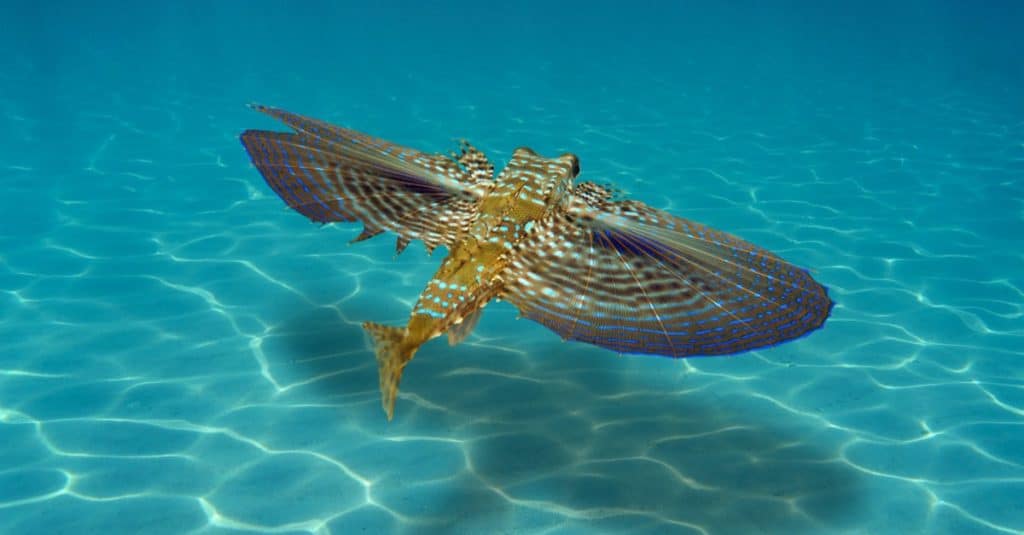
Gurnards are a family of fish (Triglidae) found in temperate and tropical waters around the world. This is an image of a
flying gurnard fish
swimming underwater over a sandy seabed.
©Damsea/Shutterstock.com
22. Grunt Sculpin (Rhamphocottus richardsonii)
The eastern Pacific Ocean is the home of the small, uniquely charming grunt sculpin. Its distinctive features include a large head, short body, and long, tapered snout. Mottled in rich tones of brown, orange, and yellow, and sporting orange-red colored fins (save the pelvic), this fish is a sight to behold. Although typically found at a modest 2 to 3 inches in length, some impressively grow up to 4 inches.
The grunt sculpin inhabits sandy and muddy bottoms of the continental shelf from California to Alaska, where it feeds on crustaceans, polychaetes, and mollusks. Often found in tide pools during low tides, they also scavenge for food in kelp beds.
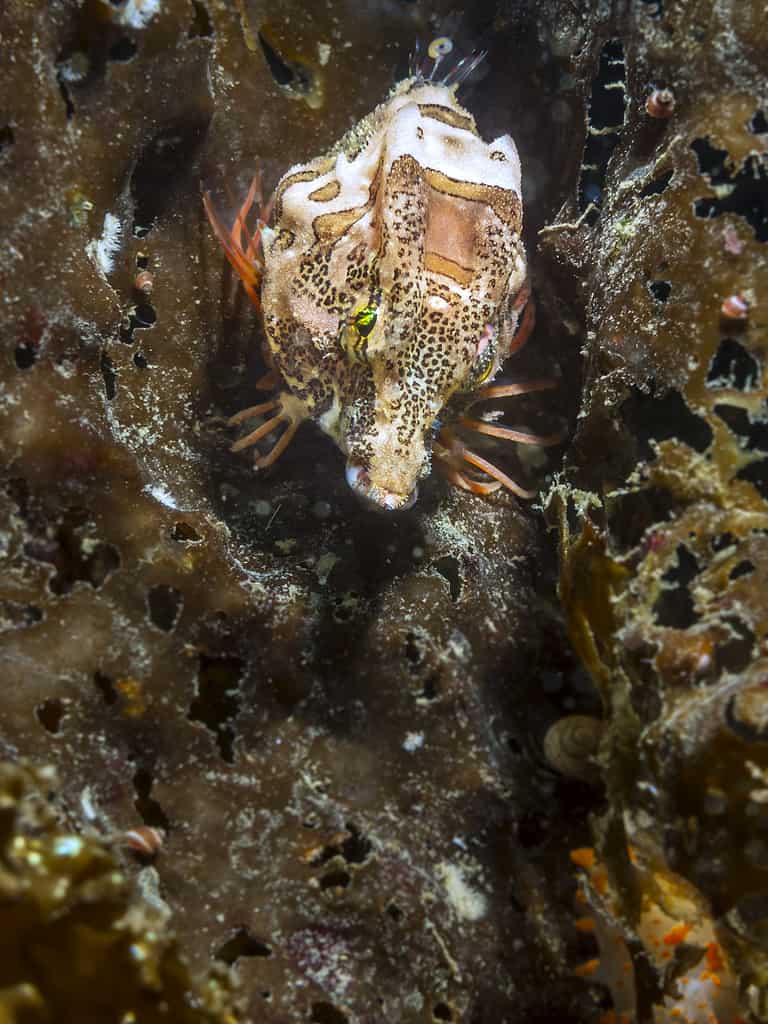
Grunt sculpin fish often hang out in empty giant
barnacle
shells close to shore.
©iStock.com/naturediver
The Largest Fish That Starts With G
The largest fish in the world that starts with G is the giant grouper (Epinephelus lanceolatus). Giant groupers can grow over 8 feet long and weigh over 800 pounds, making them one of the largest fish in the ocean. They live in tropical and subtropical waters around the world, and they are an important part of the marine ecosystem.
Giant groupers are apex predators that hunt alone and prey on various creatures such as smaller groupers, snappers, and sharks. In addition to these, they have an expansive diet and have been known to consume turtles, dolphins, and even their predators: sharks. As they stand at the top of the marine food chain, giant groupers play an important role in keeping other populations of fish in balance.
However, giant groupers are now threatened by overfishing and are an endangered species. They are often captured using spearfishing or trolling techniques. In many cultures, they are appreciated as a delicacy. Consequently, many authorities now demand special permits to catch and/or trade these fish. Therefore, we must be mindful of protecting their populations and ensuring responsible consumption to preserve these magnificent creatures for future generations.

Although very similar, the giant grouper is a different species from the goliath grouper.
©Papamoon/Shutterstock.com
The photo featured at the top of this post is ©
Thank you for reading! Have some feedback for us? Contact the AZ Animals editorial team.






